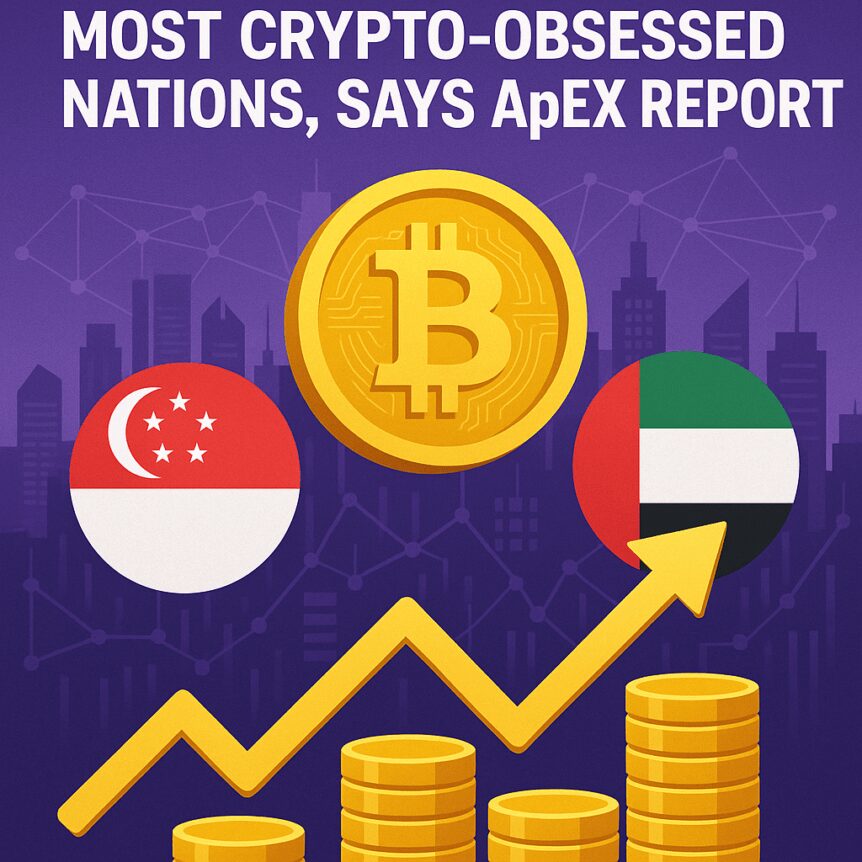Singapore & UAE Top List as Most Crypto-Obsessed Nations, says ApeX Report

As cryptocurrency adoption accelerates worldwide, certain nations stand out for their enthusiastic embrace of digital assets. Recent research reveals that Singapore and the United Arab Emirates lead the global ranks, showcasing the highest levels of engagement through varied indicators like ownership rates, search interest, and infrastructure development. This trend underscores the growing mainstream acceptance of cryptocurrencies and signals a significant shift in how countries integrate blockchain technology into their financial landscapes.
- Singapore and UAE are the most “crypto-obsessed” nations, according to ApeX Protocol.
- Singapore boasts the highest search activity and a rapidly growing digital asset ownership rate.
- The United States leads globally in crypto ATM infrastructure, with over 30,000 machines.
- Canada shows the highest growth rate in crypto adoption at 225% since 2019.
- Global interest in crypto governance expands, with nations integrating blockchain into economic frameworks.
Singapore has solidified its status as the leading hub for cryptocurrency activity, earning a perfect score of 100 in a recent report by ApeX Protocol. Its residents demonstrate a strong inclination toward digital currencies, with 24.4% owning cryptos — more than doubling the percentage from 2021. The city-state also leads global search activity regarding cryptocurrencies, with about 2,000 queries per 100,000 people. The rapid growth in digital asset ownership reflects Singapore’s proactive regulatory stance and vibrant blockchain ecosystem.
Following closely, the United Arab Emirates achieved a score of 99.7 and tops the global ownership chart at 25.3%. The UAE has experienced a 210% surge in crypto adoption since 2019, driven by favorable governmental policies and increasing digital asset acceptance among its population. Over 34% of Emiratis reported holding cryptocurrencies in 2022, underscoring the country’s rapid transition into a crypto-friendly environment.
The study assessed each country’s engagement across four key indicators: ownership rate, adoption growth, search activity, and ATM availability. Notably, the U.S. ranked third overall with a score of 98.5, primarily due to its extensive infrastructure. With more than 30,000 crypto ATMs — ten times more than any other nation — the U.S. has positioned itself as a global front-runner in accessible crypto transactions, demonstrating a 220% increase in usage since 2019.
Canada, with a 225% growth rate, also stands out, with a crypto ownership rate of 10.1% and 3,500 crypto ATMs, resulting in a score of 64.7. Turkey rounds out the top five, with a 19.3% ownership rate and strong search interest, reflecting its expanding crypto community.
Other notable markets include Germany, Switzerland, Australia, Argentina, and Indonesia, each showing rising adoption, infrastructure improvements, and growing public interest. An ApeX spokesperson highlighted that “crypto is no longer on the fringe” — it’s becoming an integral part of global financial strategies, illustrating how digital currencies are shaping the future of economic engagement.
Chainalysis: US Rises to Second in Global Crypto Adoption
According to Chainalysis’ 2025 Global Crypto Adoption Index, the United States has climbed to the second spot worldwide, fueled by increased spot Bitcoin ETF inflows and clearer regulatory frameworks. In contrast, India retains its top position for the third consecutive year, leading the Asia-Pacific region with a 69% rise in crypto transaction volumes. Countries like Pakistan, Vietnam, and Brazil also rank among the top five, while Nigeria experiences a slight dip despite regulatory advancements.
This article was originally published as Singapore & UAE Top List as Most Crypto-Obsessed Nations, says ApeX Report on Crypto Breaking News – your trusted source for crypto news, Bitcoin news, and blockchain updates.
You May Also Like

Crypto Market Prediction: Shiba Inu (SHIB) in Free Fall to Add Zero, Ethereum (ETH) Secures $4,000, Bitcoin (BTC): $110,000 Comeback Attempt

ApeX Launches APEX Token Buyback Program, Covering $12 Million in Initial Funding and 50% of Future Protocol Revenue
